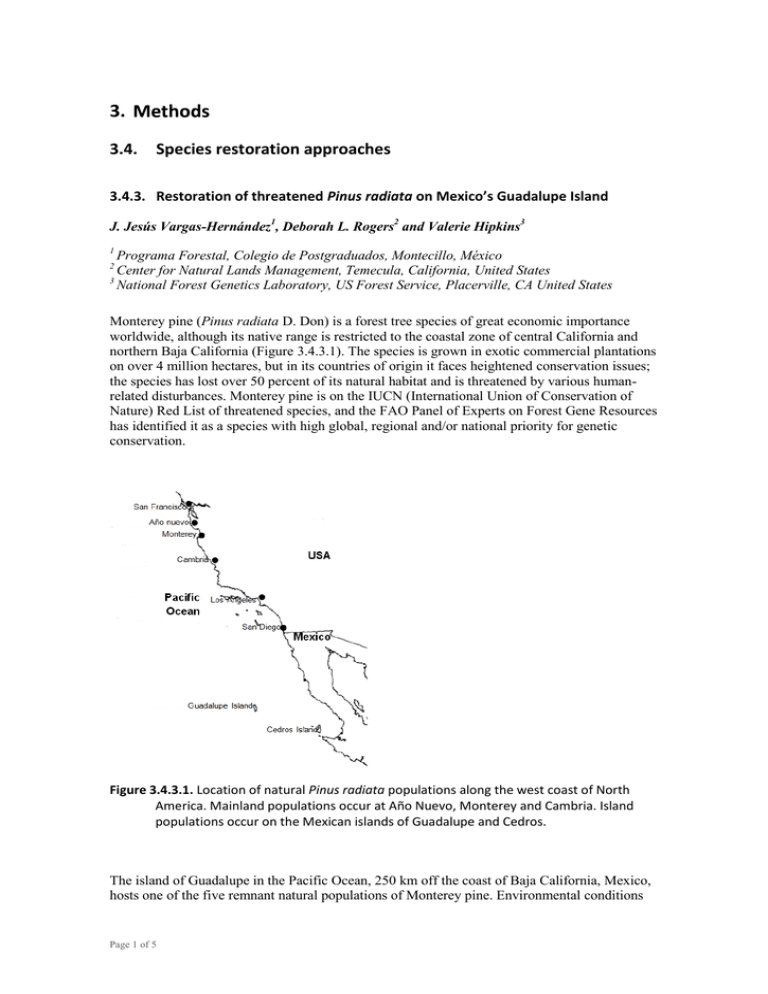3. 3.4. Species restoration approaches Pinus radiata
advertisement

3. 3.4. Species restoration approaches 3.4.3. Restoration of threatened Pinus radiata on Mexico’s Guadalupe Island J. Jesús Vargas-Hernández1, Deborah L. Rogers2 and Valerie Hipkins3 1 Programa Forestal, Colegio de Postgraduados, Montecillo, México Center for Natural Lands Management, Temecula, California, United States 3 National Forest Genetics Laboratory, US Forest Service, Placerville, CA United States 2 Monterey pine (Pinus radiata D. Don) is a forest tree species of great economic importance worldwide, although its native range is restricted to the coastal zone of central California and northern Baja California (Figure 3.4.3.1). The species is grown in exotic commercial plantations on over 4 million hectares, but in its countries of origin it faces heightened conservation issues; the species has lost over 50 percent of its natural habitat and is threatened by various humanrelated disturbances. Monterey pine is on the IUCN (International Union of Conservation of Nature) Red List of threatened species, and the FAO Panel of Experts on Forest Gene Resources has identified it as a species with high global, regional and/or national priority for genetic conservation. Figure 3.4.3.1. Location of natural Pinus radiata populations along the west coast of North America. Mainland populations occur at Año Nuevo, Monterey and Cambria. Island populations occur on the Mexican islands of Guadalupe and Cedros. The island of Guadalupe in the Pacific Ocean, 250 km off the coast of Baja California, Mexico, hosts one of the five remnant natural populations of Monterey pine. Environmental conditions Page 1 of 5 on the island are harsh, with annual rainfall averaging less than 200 mm. Although dense fogs are common in winter, especially at higher elevations, they are less frequent in summer. The volcanic-origin island has thin, rocky soils, with little organic substrate. The Monterey pine population on this island has evolved isolated from the other island and mainland populations, so it has become genetically differentiated from them, showing distinctive morphological and adaptive traits as well as genetic diversity measured with molecular markers. Some authors recognize this population with the varietal name of P. radiata var. binata. The original pine population once occupied an extensive area on the northern end of the island. However, even though the island has not been permanently inhabited by humans, the pine population shrank dramatically in the last two centuries because of goats that were introduced in the mid nineteenth century, preventing successful regeneration of the pines. The current population is down to about 220 adult, over-mature trees (2001 census), growing isolated or in small patches (Figure 3.4.3.2), in an environmental context hostile to recruitment of seedlings. The drastic reduction in population size led to the opinion that this population was headed towards extinction. In 1981 the Guadalupe Island population of Monterey pine was declared “endangered” by the FAO Panel of Experts on Forest Gene Resources largely because of the grazing pressure from introduced goats. Figure 3.4.3.2. Approximate location of remnant trees of Pinus radiata at the northern tip of Guadalupe Island (see also Figures 3.4.3.3 and 3.4.3.4). In 2001, a multinational team completed an expedition to Guadalupe Island to make seed collections of Monterey pine for conservation, restoration and research purposes. In addition to collecting seed from individual trees, the team described the status of the pines, evaluated risks and threats and gathered information on pine ecology to assist in restoration efforts. For example, before the expedition it had been speculated that microsite conditions may have deteriorated to a state that would no longer support seed germination or seedling growth. However, soil and moisture conditions, at least within the canopy and fog-drip zone of living trees, appeared to be sufficient to allow at least initial seedling establishment. The discovery of a few small pine seedlings supported the hypothesis that natural recovery may be possible if grazing pressure were reduced or removed. At the same time, a multi-institutional project, led by the Grupo de Ecología y Conservación de Islas A.C. (GECI, a binational non-governmental organization), in collaboration with several institutions from the federal government, had been initiated to eradicate the resident goat population. The eradication project started in 2000, when Page 2 of 5 Mexican ranchers from Sonora, assisted by GECI, local fishermen and the Marines stationed on the island, began trapping and removing goats for direct sale and use as breeding stock on the Mexican mainland. To test the response to release from grazing pressure, GECI installed exclusionary fencing in three areas in the pine population in summer 2001. Several years later the potential for natural recruitment of seedlings in the grazing-excluded areas was evident, as was the necessity of complete removal of the goats (Figure 3.4.3.3). The goat eradication project accomplished its goal on 2007, with Guadalupe Island being officially declared free of goats. Environmental conditions conducive to natural recruitment are one important component of the restoration process for this pine population. However, the question about whether levels of genetic diversity in the population are sufficient is still a crucial issue. Because of the rapid and presumably massive loss of pines, causing fragmentation and drastic reduction in population size, several genetic impacts may have already occurred, including reduction of genetic diversity and increased inbreeding. Thus, to ensure full recovery of the population it was important to evaluate the need for genetic intervention during the restoration process. For instance, if genetic diversity had been drastically reduced in the population, it might be important to reintroduce genetic material from ex situ collections. Similarly, if inbreeding were an issue, actions might be necessary to promote cross-pollination and seed dispersal between patches to reduce relatedness among parental trees in the next generation. Based on a spatially representative sample of germplasm from about 35 percent of the current population, genetic diversity, its spatial structure and inbreeding level were analysed using microsatellite markers. The sampling structure allowed comparison of the genetic diversity and inbreeding level in the progeny (seed) to that in the maternal generation (remnant trees). Results showed that, despite the drastic reduction in population size, the level of genetic diversity both in the parental trees and their open-pollinated progeny has not been greatly reduced. The data also indicated a minimum of 45 percent cross-pollination in the population. Thus, the genetic information obtained so far does not support the need for genetic intervention to restore this population other than to move seed among resident trees to increase dispersion distance and accelerate connectivity between patches (Figure 3.4.3.4). Although the population is still far from restored, the outlook is much more promising now than it was ten years ago. Page 3 of 5 Figure 3.4.3.3. One of the southernmost isolated, over-mature, maternal Pinus radiata trees remaining on Guadalupe Island with the natural recruitment of seedlings moving out of the protection zone under the tree canopy, May 2006. In the foreground is Deborah Rogers. Photo: Jesús Vargas-Hernández. Page 4 of 5 Figure 3.4.3.4. Panoramic view of the northern patches of remnant Pinus radiata trees on Guadalupe Island with the natural recruitment of seedlings appearing across the landscape and helping to connect the patches. Photo: Alfonso Aguirre, Director of GECI Group. Page 5 of 5






